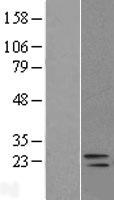DUSP26 (NM_024025) Human Tagged ORF Clone
CAT#: RC200202
DUSP26 (Myc-DDK-tagged)-Human dual specificity phosphatase 26 (putative) (DUSP26)
ORF Plasmid: tGFP
"NM_024025" in other vectors (4)
Need custom modification / cloning service?
Get a free quote
CNY 2,400.00
CNY 3,705.00
| Cited in 1 publication. |
CNY 300.00
Specifications
| Product Data | |
| Type | Human Tagged ORF Clone |
| Tag | Myc-DDK |
| Synonyms | DSP-4; DUSP24; LDP-4; LDP4; MKP-8; MKP8; NATA1; NEAP; SKRP3 |
| Vector | pCMV6-Entry |
| E. coli Selection | Kanamycin (25 ug/mL) |
| Mammalian Cell Selection | Neomycin |
| Sequence Data |
>RC200202 ORF sequence
Red=Cloning site Blue=ORF Green=Tags(s) TTTTGTAATACGACTCACTATAGGGCGGCCGGGAATTCGTCGACTGGATCCGGTACCGAGGAGATCTGCC GCCGCGATCGCC ATGTGCCCTGGTAACTGGCTTTGGGCTTCTATGACTTTTATGGCCCGCTTCTCCCGGAGTAGCTCAAGGT CTCCTGTTCGAACTCGAGGGACCCTGGAGGAGATGCCAACCGTTCAACATCCTTTCCTCAATGTCTTCGA GTTGGAGCGGCTCCTCTACACAGGCAAGACAGCCTGTAACCATGCCGACGAGGTCTGGCCAGGCCTCTAT CTCGGAGACCAGGACATGGCTAACAACCGCCGGGAGCTTCGCCGCCTGGGCATCACGCACGTCCTCAATG CCTCACACAGCCGGTGGCGAGGCACGCCCGAGGCCTATGAGGGGCTGGGCATCCGCTACCTGGGTGTTGA GGCCCACGACTCGCCAGCCTTTGACATGAGCATCCACTTCCAGACGGCTGCCGACTTCATCCACCGGGCG CTGAGCCAGCCAGGAGGGAAGATCCTGGTGCATTGTGCTGTGGGCGTGAGCCGATCCGCCACCCTGGTAC TGGCCTACCTCATGCTGTACCACCACCTTACCCTCGTGGAGGCCATCAAGAAAGTCAAAGACCACCGAGG CATCATCCCCAACCGGGGCTTCCTGAGGCAGCTCCTGGCCCTGGACCGCAGGCTGCGGCAGGGTCTGGAA GCA ACGCGTACGCGGCCGCTCGAGCAGAAACTCATCTCAGAAGAGGATCTGGCAGCAAATGATATCCTGGATT ACAAGGATGACGACGATAAGGTTTAA >RC200202 protein sequence
Red=Cloning site Green=Tags(s) MCPGNWLWASMTFMARFSRSSSRSPVRTRGTLEEMPTVQHPFLNVFELERLLYTGKTACNHADEVWPGLY LGDQDMANNRRELRRLGITHVLNASHSRWRGTPEAYEGLGIRYLGVEAHDSPAFDMSIHFQTAADFIHRA LSQPGGKILVHCAVGVSRSATLVLAYLMLYHHLTLVEAIKKVKDHRGIIPNRGFLRQLLALDRRLRQGLE A TRTRPLEQKLISEEDLAANDILDYKDDDDKV |
| Chromatograms |
CHROMATOGRAMS
 Sequencher program is needed, download here. |
| Restriction Sites |
SgfI-MluI
Cloning Scheme for this gene
Plasmid Map

|
| ACCN | NM_024025 |
| ORF Size | 633 bp |
| OTI Disclaimer | The molecular sequence of this clone aligns with the gene accession number as a point of reference only. However, individual transcript sequences of the same gene can differ through naturally occurring variations (e.g. polymorphisms), each with its own valid existence. This clone is substantially in agreement with the reference, but a complete review of all prevailing variants is recommended prior to use. More info |
| OTI Annotation | This clone was engineered to express the complete ORF with an expression tag. Expression varies depending on the nature of the gene. |
| Product Components | The ORF clone is ion-exchange column purified and shipped in a 2D barcoded Matrix tube containing 10ug of transfection-ready, dried plasmid DNA (reconstitute with 100 ul of water). |
| Reconstitution | 1. Centrifuge at 5,000xg for 5min. 2. Carefully open the tube and add 100ul of sterile water to dissolve the DNA. 3. Close the tube and incubate for 10 minutes at room temperature. 4. Briefly vortex the tube and then do a quick spin (less than 5000xg) to concentrate the liquid at the bottom. 5. Store the suspended plasmid at -20°C. The DNA is stable for at least one year from date of shipping when stored at -20°C. |
| Reference Data | |
| RefSeq | NM_024025.3 |
| RefSeq Size | 1665 bp |
| RefSeq ORF | 636 bp |
| Locus ID | 78986 |
| UniProt ID | Q9BV47 |
| Domains | DSPc |
| Protein Families | Druggable Genome, Phosphatase |
| MW | 23.9 kDa |
| Gene Summary | This gene encodes a member of the tyrosine phosphatase family of proteins and exhibits dual specificity by dephosphorylating tyrosine as well as serine and threonine residues. This gene has been described as both a tumor suppressor and an oncogene depending on the cellular context. This protein may regulate neuronal proliferation and has been implicated in the progression of glioblastoma through its ability to dephosphorylate the p53 tumor suppressor. Alternative splicing results in multiple transcript variants. [provided by RefSeq, Feb 2015] |
Citations (1)
| The use of this cDNA Clones has been cited in the following citations: |
|---|
|
Decreased DUSP26 Expression Promotes Malignant Behavior in Glioblastoma Cells via Deregulation of MAPK and Akt Signaling Pathway
,null,
Frontiers in Oncology
,PubMed ID 33718185
[DUSP26]
|
Documents
| Product Manuals |
| FAQs |
| SDS |
Resources
Other Versions
| SKU | Description | Size | Price |
|---|---|---|---|
| RC200202L3 | Lenti ORF clone of Human dual specificity phosphatase 26 (putative) (DUSP26), Myc-DDK-tagged |
CNY 5,890.00 |
|
| RC200202L4 | Lenti ORF clone of Human dual specificity phosphatase 26 (putative) (DUSP26), mGFP tagged |
CNY 5,890.00 |
|
| RG200202 | DUSP26 (tGFP-tagged) - Human dual specificity phosphatase 26 (putative) (DUSP26) |
CNY 4,000.00 |
|
| SC112322 | DUSP26 (untagged)-Human dual specificity phosphatase 26 (putative) (DUSP26) |
CNY 2,400.00 |


 United States
United States
 Germany
Germany
 Japan
Japan
 United Kingdom
United Kingdom
 China
China



